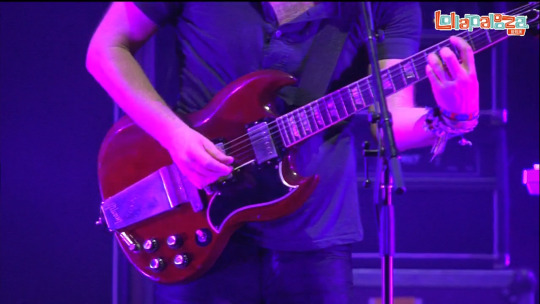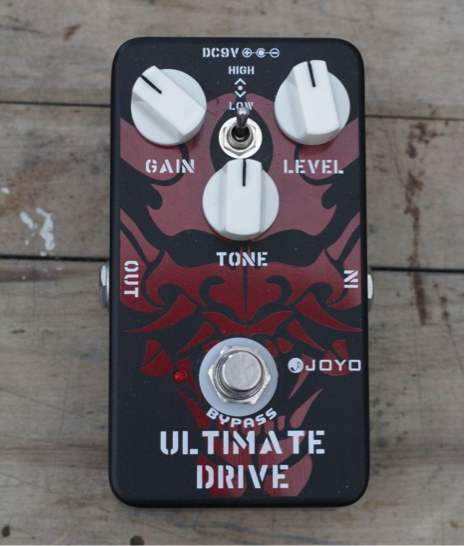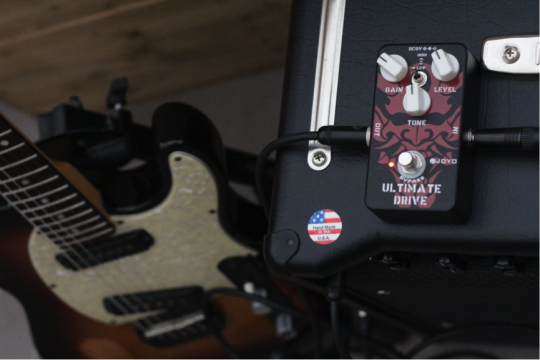#if I find reasonably priced potentiometers
Text
Finally, finally managed to make the Squier Jazzmaster I found a couple of months ago decently playable and damn, it might be the most resonant guitar I have even though it's pretty banged up
#now I kinda want to mod it further...#if I find reasonably priced potentiometers#the gold anodized pickguard is probably overkill on such a cheap guitar but uh.#my toxic trait is that I like eye catchy stuff on guitars lol#guitar tag
2 notes
·
View notes
Note
I love the sound of Thom's 1964 Cherry Red Gibson SG No1, but it is crazy expensive. How can I achieve this sound with a guitar more in the mid price range?

A close-up of one of Thom's vintage 1960s Gibson SG guitars during Reckoner at Lollapalooza Berlin on September 11, 2016 (radiohead.com). Note that the Vibrola arm is removed.
Replicating the sound of Thom’s vintage SG is basically the same as replicating the sound of Jonny’s Les Paul. Find any solid-body guitar with a 24-3/4" scale length and a tune-o-matic bridge. Then add some vintage-style PAF humbuckers. That’s it. Then learn how to gently finger-strum like Thom on House of Cards and Reckoner. To be fair, it's hard to overstate how important the detail of Thom's finger-style (the way the finger crosses the strings, the picking location, etc) is to his sound on those tunes.
Thom could easily get the same sounds from Jonny’s Les Paul or from his own vintage Les Paul. But the SG is a much lighter and more comfortable guitar to play, which is probably the reason Thom prefers them, similar to his preference for short-scale basses.
You could get the Epiphone SG Standard 60s Maestro Vibrola, which is an Epiphone reissue of Thom’s vintage SG. The main issue with modern Epiphones seems to be quality control, so you’d want to try one in a store to make sure it plays ok. But if it does play well, it can certainly sound as good as a Gibson. And it can sound just like a Gibson if you swap in Gibson pickups. Of course, the resale value won’t be as stable as for a Gibson, but it’s so much cheaper that it’s hard to complain.
However, Thom has the Vibrola arm removed from his vintage SG. So there’s no need to buy a reissue with the Vibrola, unless you personally want to use it or just for aesthetic reasons.
Two of the same model solid-body guitars with the same pickups will probably still sound slightly different from each other when plugged-in (for example, two Fender Player Series Jaguar guitars). Many will suggest this is due to wood choice, finish type, guitar “quality”, etc. While those things may matter on acoustic guitars, they don’t on solid-body electrics. Instead, the difference in sound is just a result of electrical component tolerances. Potentiometers and capacitors can vary by 20% at the “same” value, and this can cause guitars to sound noticeably brighter or darker. Luckily, if your guitar sounds a bit brighter than Thom’s you can simply turn down the tone knob.

Thom with one of his vintage 1960s SG guitars at Lollapalooza Chicago on July 29, 2016 (lesserwiener).
13 notes
·
View notes
Note
How do you feel about pleos? I can't afford one anytime soon but I want one so badly, but I also know little about them that isn't directly information from the manufacturer.
I love Pleos! They’re really calm and relaxing robots to have around and of course, who doesn’t want a pet dinosaur? The Pleo RBs require a lot of care (feeding, running in the correct lighting + temperature, running frequently enough, etc) to stay happy and healthy (they simulate illnesses and injuries when not cared for properly), while the Ugobe Pleos are much more easy going. Both models are pretty different, so it’s definitely important to do some research into which suits you best!
However, the quality control on Pleos is a bit lacking. Pleo RBs seem to fail very frequently (the wires at the knee potentiometers are very prone to coming loose) and I’ve had to return about half of the ones I purchased new for replacements which is really disappointing. Ugobe Pleos are more durable overall, but still can develop snapped neck cables or skin issues and working batteries for this model are very difficult to find at a reasonable price since nearly all of the originals are dead by now.
Feel free to message me if you want more info on them or have any specific questions!
7 notes
·
View notes
Text
Adrian’s Mods - The Joyo Ultimate Drive
Our latest pedal comes from Adrian, and although its not old it still has a tale to tell. It’s interesting how things get modded, adapted and there endless ways that you can engage in making and modding pedals sound like “this and that”.
Adrian says “ I have passed on my ‘modded’ Joyo Ultimate Drive pedal. This is not an old pedal with a rich history, but it does have its own story and one that highlights the world of guitar pedals and the mind of the electric guitarist.”

First a bit of background …
I used to play the guitar a lot in earlier years but for a number of reasons too boring or inconsequential to outline here I took an extended hiatus from playing about 15 years ago. In recent years a growing desire to spend time playing again has resurfaced and I feel refreshed and eager, albeit extremely rusty. Alongside there is also a renewed desire to buy loads of new gear! At around the time I stopped playing most of my stomp boxes were stolen … well, I say stolen, the truth of the matter being that at the end of a rehearsal I drove off into the sunset leaving a large holdall with my pedals, leads and assorted items on the pavement. However, at the time I was living the 80’s / 90’s guitarist dream, so my main set up consisted of a rack mounted preamp and power amp with midi controlled digital multi-effect processors and a two speaker cabinets for those glorious stereo chorus and delay patches … yes, I was that cool. I discovered that this equipment has not aged well over the years, both in terms of its sound and reliability. The latter was revealed when I dragged my flightcase of gear out of the garage, brushed off the dust, plugged it in, powered it up and lo and behold I wasn’t greeted with a squealing fanfare of joy, but rather silence. Thus, it became clear that I would need to start scratch. But this is not a sad story, on the contrary, the life of the electric guitarist revolves around three main activities that each vie for prominence: playing the guitar, buying guitar related equipment and thinking about buying guitar related equipment. So, I’ve gladly embraced this period of discovery and research; pouring through YouTube videos of demos of this amp, that guitar, this pedal and that pedal, convincing myself at each turn this is what I need to get the holy grail of tone.
Electric guitar equipment is steeped in the folklore of those heady days of the 50’s, 60’s and 70’s when guitars, amplifiers and pedals were (apparently) made properly. The standards were set during these times, such as the sound of a Fender Stratocaster plugged into a Deluxe Reverb or a Gibson Les Paul into a flat out Marshall Plexi. These objects have defined the archetypical ‘tones’ as captured on our favourite records by our favourite players. Accordingly, guitarists on the whole do not look forward, but rather we look back to these glory days and we strive to attain these classic artefacts and their benchmark tones … or more practically speaking, we strive for something cheaper that sounds the same! (note: these ‘cheaper’ alternatives nonetheless need to demonstrate lineage to these classic designs … “Oh yeah, my [insert choice of amplifier manufacture here] uses the same NOS valves and orange drop capacitors as the original Vox AC30” or “My [insert stompbox drive pedal of choice here] uses the same JRC4558D chip as the original Tube Screamer” etc, etc).
A guitarist’s sound is a very particular business. This retrospective view on what electric guitar tones should be place manufacturers in a difficult spot, which can be seen by a survey of their product descriptions. On the one hand R&D time and resources are spent trying to carve out space in the market for new products, but on the other hand these new products are largely required to deliver what we expect, namely the old established tones. So, the same designs and circuits are revisited time and time again, being ever so slightly iterated to permit lofty claims of an improvement to the old one.
But, what does this have to do with my Joyo Ultimate Drive pedal? Well, my journey for a new setup started with many hours spent researching pedal products. I discovered that in recent years there has been a renaissance in effect pedals, there’s a crowded marketplace of bespoke pedal manufacturers offering a range of wares, the majority being individual recipes on the established circuits. Being a cheapskate, I then discovered the DIY end of the market, where you can buy an exact ‘clone’ of your favourite pedal in kit form to be assembled by yourself for a fraction of the cost of the real thing. One such product caught my eye, a kit clone of the Hermida Audio Zen Drive, a popular pedal that claims to mimic the overdriven sound of the highly revered Dumble Overdrive Special Amplifier. Apparently only 300 or so hand made Dumble amps were built. As legend has it one did not simply go and buy a Dumble Amplifier, but rather Mr Dumble decided if you were worthy to own one of his amplifiers. For many years the inner workings of these amplifiers were clouded in mystery as Mr Dumble worked hard to protect his design from being copied. He would cover his circuit boards in ‘goop’ (epoxy resin) to hide the components and circuit from being analysed. Furthermore, if you were one of the lucky ones who were allowed to buy one of his amplifiers (they tended to be high profile players such as Larry Carlton, Robben Ford, Stevie Ray Vaughan, Carlos Santana et al.) you had to sign a contract agreeing not to reveal any details about the amplifier. The following quote from the contract shows the degree Mr Dumble went to hide his work:
“I promise to never allow the equipment to be opened, analized, and/or inspected by any individual, group of individuals, and/or commercial entity other than H. Alexander Dumble. I also agree and promise that I will always maintain the strict supervision over the equipment; and to never leave it vulnerable to theft and/or inspection/analization by any individual, group of individuals, and/or commercial entity. I further agree and promise that I will not sell the equipment built for me by H. Alexander Dumble to any individual, group of individuals, and/or commercial entity that will invade and/or compromise the secrecy of H. Alexander Dumble's circuitry and techniques used in the manufacturing of his equipment”
Needless to say that over the years Dumble amps were indeed sold on, de-gooped, analysed, cloned and copied and now a wide range of bespoke amplifier manufacturers sell their exact replica or iteration of the Dumble amp to eager players (e.g. Two Rock, Fuchs, Ceriatone, Carol Ann, Bludotone). Original Dumble’s are highly sought after and owners demand exorbitant prices for them; they are the worlds most expensive amplifiers, as this current advert contends, a mere £96,413.31. Back to the story … So, my thought process was a follows: buy a DIY pedal kit for £16.79 that I have been assured will sound just like a real Zen Drive pedal (retails at £185) that I have been assured will sound just like a Dumble Overdrive Special Amplifier (£96,413.31 second hand). This sounded like a reasonable proposition to me, so I placed my order and received my Zen Drive kit a week later. I then discovered that my soldering ‘chops’ were as rusty as my guitar ‘chops’, further hampered by a soldering iron whose tip had all the precision of a butter knife. So, unfortunately the kit suffered “manufacturing issues” and my quest for the Dumble tone stalled.
I returned to my pedal research to discover a number of companies selling pre-manufactured ‘working’ clones of your favourite pedal for a fraction of the price of the original. These pedals obviously are bestowed with different names and designs than the original, but it doesn’t take much digging to reveal the copied pedal. Apparently circuit board designs are not protected by intellectual copyright (unqualified statement alert!). One such clone that received great reviews across the web was the Joyo Ultimate Drive, a clone of the well-liked Fulltone OCD overdrive and distortion pedal, a bargain at £31.03 (Incidentally, it is claimed that the Fulltone OCD pedal is essentially a copy of the RAT Distortion pedal).
I took the plunge and bought the Joyo without hearing one in the flesh or the real Fulltone OCD for that matter. On receipt of the Joyo my impressions of the pedal were largely of disappointment, it’s not that it sounded bad, but it was not really what I was after.
I continued to read up online about the Joyo Ultimate Drive pedal and came across this interesting story. It appears that a certain boutique pedal manufacturer was (allegedly) caught bulk buying the Joyo Ultimate Drive pedal, changing three of the components (swapping a capacitor for a different value and adding resistors to the gain and tone potentiometers), gooping the circuit board to cover the ‘Joyo Ultimate Drive’ text printed on the board and re-housing them in new case - Alpha Drive re-branding of Joyo Ultimate Drive.
They were then sold on at a ‘boutique’ price and marketed as a pedal that re-creates the sound of a Dumble amp! Putting the ethics of this aside, what peaked my interest was that this exposé meant his minor modifications were charted across various online guitar forums. So, having bought a new soldering iron I set to work to undertake the same ‘mods’ to my Joyo. This proved to be a more successful process than my previous effort and the sound of the pedal was indeed changed and greatly improved to my ears. Whether it sounds a like a Dumble amp or not I have no idea, never having played one, nor do I suddenly sound like Robben Ford or Stevie Ray Vaughan! The latter I have yet to figure out why…?

I have since moved on from my initial exposition into buying ‘something’s for nothing’ bathed in snake oil. I now own a number of other (non clone) pedals that better suit my taste and I find my Joyo Ultimate Drive taking a back seat on my pedal board. It seems appropriate that this pedal – a copy of a Fulltone OCD, which is a copy of a RAT Distortion that has been then modified to be a copy of a Dumble amp etc – should be transformed once more in the hands of a new player.
0 notes